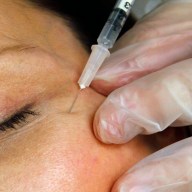They’re tinier than ants in your pants, smaller than specks of dirt on your living-room window.
And with amazing powers once thought possible only in the space-age world of the Jetsons, particles created through the magic of nanotechnology are making our pants resist stains and wrinkles and helping windows in our homes miraculously clean themselves.
From socks and jock straps that don’t get smelly to germ-free toilets and kitchen utensils, cutting-edge skin creams and strong-as-steel hockey sticks, products created through this relatively new science are probably already a part of your life, even though you may not know it.
Or they soon will be.
“It is huge. It is going to possibly affect all aspects of our lives,” scientist Elizabeth Nielsen, a consultant with the Consumers Council of Canada, said in an interview with The Canadian Press.
“(Nanotechnology) comes along as a foundation technology, like the industrial revolution and electricity.”
Nanotechnology involves the manipulation of molecules at the atomic level. Special microscopes and equipment create devices with unique properties. The smaller the matter, the more reactive it can be and the easier it can move through the body, air and water.
For instance, titanium dioxide and zinc oxide used in sunscreens become transparent when they are cut down to nano size, but they can still absorb and reflect ultraviolet light.
While nanotechnology means that such materials can do things never before thought possible, critics are warning that not nearly enough is known about how these altered materials might affect the human body and the environment.
That uncertainty has fuelled a type of “nanophobia,” as the New York Times recently called it, that has prompted companies that once proudly displayed the use of the technology in their products to remove the word from their advertising for fear of alienating consumers.
Not long ago, the nano name was a huge selling feature for cosmetics in Europe, Nielsen says. But after fiction-writer Michael Crichton released his book “Prey” in 2002, all references to nanotechnology were removed from their labels. The novel is about a scientist who unwittingly unleashes a swarm of deadly nanoparticles into the world.
Nielsen agrees that consumers should be wary of some nano products. There simply isn’t enough research happening to know what risks, if any, are posed by them, she says.
“It’s really buyer beware in many cases right now.”
Until research can catch up with the exploding nano market, she suggests consumers at least stay away from nano products for children.
“They don’t really know what the impact would be on children who are a much more vulnerable group.”
People with children take note. Anti-bacterial baby bottles and soothers and stain-resistant plush toys sound wonderful and they are already on the market, but they might deserve a second look.
Colin Finan with the Project on Emerging Nanotechnologies, based out of the Woodrow Wilson International Center for Scholars in Washington, D.C., says the amount of money being used to create products with nanoscale materials is set to skyrocket.
Roughly $147 billion was spent around the globe in 2007. He says that figure is expected to soar to $3.1 trillion by 2015.
The project has listed more than 800 nano products already on the market, and three to four new ones are added every week. Most of them, an estimated 80 per cent, are available to Canadians through retail stores, distributors or the Internet. The inventory includes pencils that release aromas while you write, plastic beer bottles that keep beer fresher for longer and cigarette filters that provide cleaner taste and reduce toxins.
There are also the female foam condom, baseball caps with germ-free bands, static-free tuques and speedier Speedo swimsuits.
Not enough yet? How about stronger tennis rackets, hockey sticks, golf clubs, bicycles and snowboards.
For the car, there’s scratch-resistant paint, tires that grip the road better and windshield cleaner that can repel snow, bugs and grime.
Look to the kitchen for containers that keep food fresher longer and other packaging that changes colour to warn if food is contaminated. Nano particles are even in some of the foods we eat, making chocolate ice cream creamier and diet shakes work faster.
All kinds of nano products are available, says Nielsen, but most shoppers have no clue that nanotechnology played a role in their making. Some tags on clothing and labels on paint cans and tools advertise nanotechnology, but many other items don’t.
Milana Segal with Green Earth Nano Science in Toronto promises that her company’s nano product is entirely safe. It’s a special coating that reacts with the sun on the outside of buildings to keep them clean and free of mould and mildew. On the inside, another coating can be applied to walls and ceilings to deodorize, purify the air and prevent the spread of bacteria.
The product is only in the pilot stage, says Segal, but she predicts within a decade it will be everywhere.
“We want to see it in homes. We want to see it in hospitals. We want to see it in schools.”
Nanotechnology, she suggests, will change life for everyone. “It’s like when the Internet came out 10 years ago and nobody knew what it was. Today everybody needs it.”
And it would seem that the future holds no bounds. Researchers in the United States announced last year that they are working on an invisible, electromagnetic cloak that can bend light around itself. That work, which is funded by the U.S. army, holds the potential of making armoured tanks invisible.
















